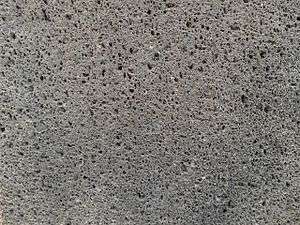Trachyandesite
Trachyandesite is an extrusive igneous rock with a composition between trachyte and andesite. It has little or no free quartz, but is dominated by alkali feldspar and sodic plagioclase along with one or more of the following mafic minerals: amphibole, biotite or pyroxene. Small amounts of nepheline may be present and apatite is a common accessory mineral.[1]


Trachyandesite falls into the S3 field of the TAS classification.[2]
Trachyandesitic magma can produce explosive Plinian eruptions, such as happened at Tambora in 1815.[3]
Varieties
Sodium-rich trachyandesite (with %Na2O > %K2O + 2) is called benmoreite, while the more potassic form is called latite. Basaltic trachyandesite is transitional to basalt and likewise comes in two varieties, mugearite (sodium-rich) and shoshonite (potassium-rich).[4]
References
- Neuendorf, Klaus K.E.; Mehl, James P., Jr.; Jackson, Julia A. (2011). Glossary of geology (Fifth revised ed.). American Geological Institute. ISBN 9781680151787.
- Le Bas, M. J.; Streckeisen, A. L. (September 1991). "The IUGS systematics of igneous rocks". Journal of the Geological Society. 148 (5): 825–833. doi:10.1144/gsjgs.148.5.0825.
- Self, S.; Gertisser, R.; Thordarson, T.; Rampino, M. R.; Wolff, J. A. (2004). "Magma volume, volatile emissions, and stratospheric aerosols from the 1815 eruption of Tambora" (PDF). Geophysical Research Letters. 31 (20): L20608. Bibcode:2004GeoRL..3120608S. doi:10.1029/2004GL020925.
- Philpotts, Anthony R.; Ague, Jay J. (2009). Principles of igneous and metamorphic petrology (2nd ed.). Cambridge University Press. ISBN 9780521880060.
